

Yankee Doodle (Nursery Rhymes and Good Old Times CD)
Yankee Doodle went to town (Place one foot in front of the other
A riding on a pony. and rock back and forth to the beat.)
He stuck a feather in his cap, (Pretend to put feather on head.)
And called it macaroni.
Yankee Doodle, keep it up. (Rock back and forth as you pretend
Yankee Doodle dandy. to hold your reins.)
Mind the music and the step, (Hands on hips. Stick out heels.)
And with the girls be handy. (Bow from waist.)
Activities:
Have children choose a friend and hold hands and rock back and forth as they sing.
Practice crossing the midline by giving the children a real feather or paper feather to wave in the air as they sing. Have them follow along as you make lazy eights (sideways 8) in the air in front of your body with your right hand. Make lazy eights with your left hand. Hold the feather in your right hand and bend and touch your left knee. Hold the feather in your left hand and bend and touch your right knee. Make giant circles in the air above your head with the feather. Pass the feather around your body from the left to the right hand. Let children toss feathers in the air and then try and catch them.
Hint! Use painter’s tape and tape a strip down the middle of the child’s body. Practice singing songs and doing movements where they must cross the midline.
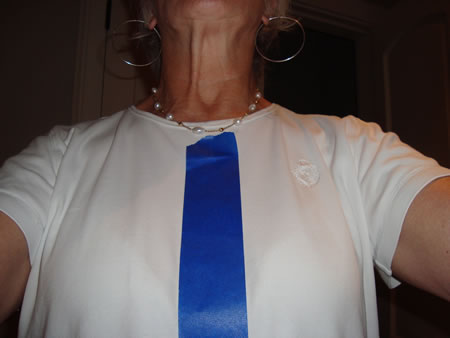
Make Yankee Doodle hats from newspaper. Fold a sheet of newspaper in half. Fold down the top corners to the middle. Bend one section of the bottom up. Turn over and bend the other section of the bottom up. Staple at the corners. Let children decorate with markers and a paper feather.

What does it mean to be “dandy”? Explain that when you don’t know what a word means you look it up in the dictionary. Model looking up that word and other words you come to in rhymes and songs that the children may not be familiar with.
I’m a Little Teapot (Nursery Rhymes and Good Old Times CD)
I’m a little teapot short and stout. (Hands on hips.)
Here is my handle. (Stick out one arm.)
Here is my spout. (Other arm on hip.)
When I get all steamed up then I shout,
“Just tip me over and pour me out.” (Bend over as if pouring tea.)
Activities: Teach children this silly version. Place both hands on your hips and sing:
I’m a little teapot short and stout.
Here is my handle. (Stick one hand on hip.)
Here is my ???? (Place other hand on hip.)
Oops! I’m a sugar bowl.
Here’s a finger play about tea:
Here’s a cup. (Hold up right hand.)
And here’s a cup. (Hold left hand.)
And here’s a pot of tea. (Put hands together.)
Pour a cup. (Pretend to pour in right hand.)
And pour a cup. (Pour in left hand.)
And have a cup with me! (Pretend to drink.)
Reinforce segmenting and blending sounds with a sound sack. Place several objects in the bag and sing this song to the tune of “I’m a Little Teapot.”
What’s in the sound sack,
Who can tell?
Maybe it’s a book
Or maybe it’s a shell?
What’s in the sound sack
Who can say?
Blend the sounds, you’ll know right away.
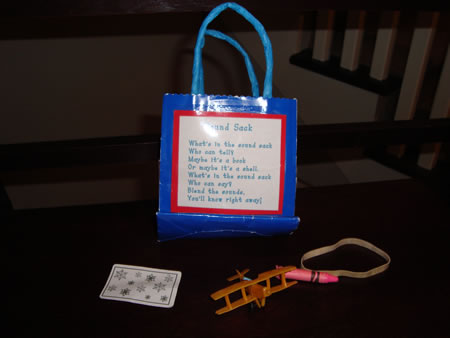
One at a time stretch out the sounds you hear in each object. As children blend the sounds and say the word pull the object out of the bag. When all the objects are out of the bag, tell the children they will have to stretch out the sounds before you can put them back in the bag. Use your fingers to demonstrate pulling the sounds in the word apart before placing it back in the bag.
Home on the Range (Nursery Rhymes and Good Old Times CD)
Oh, give me a home, (Pretend to strum guitar.)
Where the buffalo roam,
Where the deer and the antelope play.
Where seldom is heard, a discouraging word,
And the skies are not cloudy all day.
Home, home on the range.
Where the deer and the antelope play.
Where seldom is heard, a discouraging word,
And the skies are not cloudy all day.
Activities: Select several children to be coyotes. The coyotes get down on all fours and howl as the song is sung.
Ask the children to close their eyes as you sing and make pictures in their brain. Give each child a sheet of paper to illustrate the “picture” that they saw in their head. Add words from the song to each page and put them together to make a class book. Be sure to include a page for authors and illustrators. Let them dedicate the book and add the publisher and copyright. You might also want to include a page that says “The End” and a page for “Compliments and Comments.”
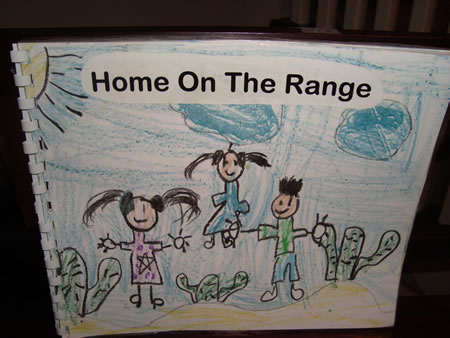
Discuss what a desert habitat is. What kinds of plants and animals would you find on a desert habitat? Why? Talk about other habitats, such as the rain forest, woodlands, arctic, etc. Let children make “pop ups” of various habitats. Fold a sheet of construction paper in half. Cut two 2” slits from the fold as shown. Bend in the tab. Open and draw the background for the habitat. Children draw an animal that could be found in that habitat and glue it to the tab so that when it is opened the animal pops up.
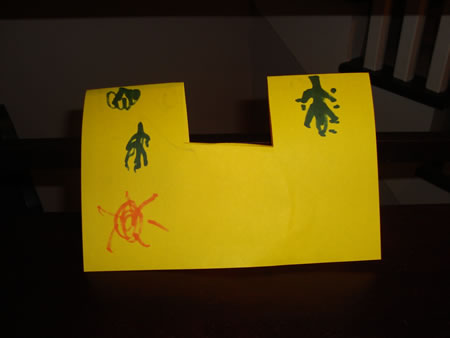
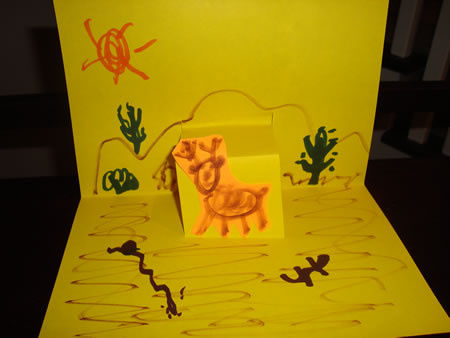
Make trail mix. Let children put a spoonful of fish crackers, raisins, Cheerios, pretzels, and any other small snack in a paper bag. Shake. Pour into an ice cream cone to eat. There’s no mess because you can just eat the cone when you’re finished with the trail mix.
Do the cowboy cheer. Put your index finger in the air and twirl it around like a lasso as you say, “Yeehaw!”
The Mulberry Bush (Nursery Rhymes and Good Old Times CD)
Here we go round the mulberry bush, (Hold hands and skip in a circle.)
The mulberry bush, the mulberry bush.
Here we go round the mulberry bush
So early in the morning.
This is the way we wash our clothes, (Pretend to wash clothes.)
Wash our clothes, wash our clothes.
This is the way we wash our clothes,
So early Monday morning.
Tuesday – iron our clothes (Pretend to iron clothes.)
Wednesday – scrub the floor (Get on hands and knees to scrub.)
Thursday – mend our clothes (Pretend to needle and thread and sew.)
Friday - sweep the house (Pretend to sweep.)
Saturday – bake our bread (Make circle with one hand and stir.)
Sunday – smile and sing (Smile!)
Activities:
Let children make up their own verses and movements for the song by integrating classroom activities. For example: “This is the way we run and jump at PE Monday Morning,..This is the way we draw and paint at art Tuesday afternoon…This is the way we read our books at library Wednesday morning…”
Have children make a “Good News” journal. Fold two sheets of paper in half and staple. Let them decorate the cover with “My Good News” and then write a day of the week on each page. Before leaving at the end of each day encourage them to draw a picture of something “good” that happened that day. Older children could write their own sentences while younger children could dictate sentences. Let them take their books home on the weekend to share with their families and complete their books.
Invite children to pantomime motions from the song and other motions as their friends try to guess what they are doing.
Say the days of the week roller coaster style. Start with your hands down low for Sunday. As you say each day make your hands go up and increase the volume of your voice until you come to the present day. Move your hands down as you say the following days with a softer voice. Sing and write using this idea you can download by clicking on Downloads in the menu at the top left.
Jack Be Nimble (Nursery Rhymes and Good Old Times CD)
Jack be nimble. (Hands behind back.)
Jack be quick.
Jack jump over (Jump forwards.)
The candlestick.
Jump it lively.
Jump it quick.
But don’t knock over (Jump backwards.)
The candlestick!
Activities:
Place a block on the floor to be the “candlestick.” Children take turns jumping over it as you say their name in the rhyme. For example: “Tasha be nimble, Tasha be quick…”
Use children’s names to reinforce phonological awareness.
Make picture name cards for the children in your classroom by writing their names on an 10” sentence strips. Glue their photo to the left end. Use the name cards for signing in, transitions, songs, and other activities.
Cut off the left edge of an envelope. Insert the name cards in the envelope. Pull out one letter at a time as children try to blend sounds and predict whose name it might be.
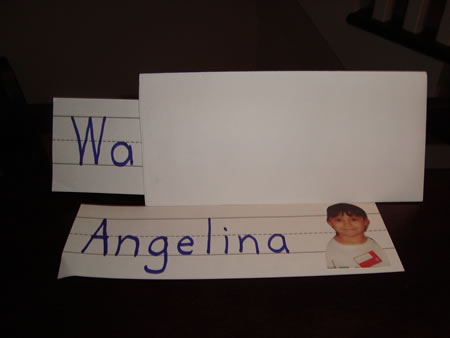
Make name puzzles for each child. Write each child’s name on an envelope. Invite them to decorate the envelope with a picture of themselves. Take an 8” section of sentence strip and write the child’s name on it. Cut between the letters in puzzle designs. Place the letters in the envelope. Place the envelopes in a center. Children can take turns putting the letters in their friends’ names together.
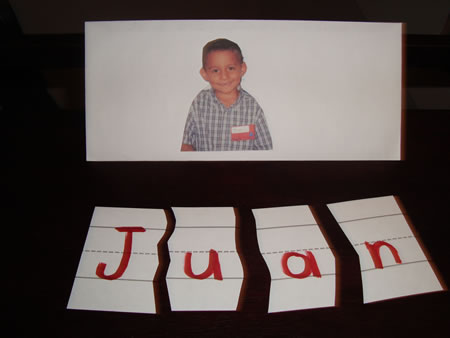
Hint! Write the name on the back of the envelope so children have a model if they need one.